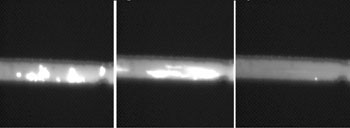| Posted: April 24, 2008 |
Finding the reaction rates for a particle-in-a-chip |
|
(Nanowerk News) How does trapping a nanoparticle in a microdevice affect its reactions? US scientists are answering this question thanks to a straightforward method using fluorescent tags ("Measuring reaction rates on single particles in a microfluidic device" – free access article).
|
 |
| Capture and release of fluorescently tagged magnetic particles in a microchip
|
|
Meghan Caulum and Charles Henry at Colorado State University in Fort Collins, US, have developed what they say is 'a simple, inexpensive way to monitor reactions at the surface of magnetic particles within a microfluidic device.' The researchers used their method to look at reaction rates in the system.
|
|
Using small magnetic particles in microfluidic systems has great potential in chemical synthesis and biological techniques such as immunoassays, declare Caulum and Henry. But few researchers so far have studied how reaction rates at the particle surfaces differ in microfluidic devices from those in solution. Caulum and Henry say that understanding the processes involved is important when trying to optimise previously solution-based assays on-chip.
|
|
The duo's technique is based on following a bond-breaking reaction inside a microfluidic device. A reducing agent is made to flow over fluorescently tagged particles captured inside the device by magnets. This breaks disulfide bonds that link the tags to the particle surfaces, reducing the fluorescence. By monitoring the loss of fluorescence with time, the researchers can measure the reaction's kinetics.
|
|
Sabeth Verpoorte, head of the pharmaceutical analysis group at the University of Groningen in the Netherlands, says 'There is no doubt that combining micro- and nanoparticles with microfluidics will lead to powerful new approaches for chemical and biochemical processing and analysis. This work represents a significant step forward in this area, as it yields new information on particle-based reactions and handling.'
|

